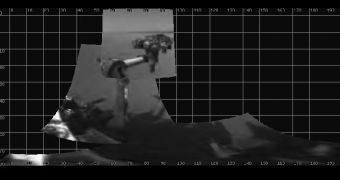The Mars Science Laboratory (MSL) rover Curiosity stretched its robotic arm for the first time yesterday, August 20, in more than 8 months. The last time the instrument carried out any action was before the robot's November 2011 launch.
Scientists at the Jet Propulsion Laboratory (JPL) in Pasadena, California, who manage MSL for the NASA Science Mission Directorate in Washington DC, say that the testing and commissioning phases of the mission are progressing smoothly.
Over the past couple of days, mission controllers selected Curiosity's first science target. California Institute of Technology (Caltech) expert and Curiosity Principal Investigator, John Grotzinger, says that the target area is called Glenelg.
It represents a naturally occurring intersection between three different types of terrain, and may therefore help reveal more about their nature. Glenelg is located about 400 meters (1,300 feet) away from Curiosity's current position, bearing east-southeast.
The rover also fired its mast-mounted laser for the first time on Sunday, August 19. The device is part of the Chemistry and Camera (ChemCam) instrument. The target was the nearby Rock N165.
Yesterday, scientists ordered the 2.1-meter (7-foot) robotic arm on MSL to carry out a series of maneuvers meant to test its functionality. It carries a series of scientific instruments, including a drill, a camera, a scoop, a spectrometer, and a series of mechanisms for portioning rock and soils samples.
“We have had to sit tight for the first two weeks since landing, while other parts of the rover were checked out, so to see the arm extended in these images is a huge moment for us,” Matt Robinson says.
“The arm is how we are going to get samples into the laboratory instruments and how we place other instruments onto surface targets,” adds the expert, who is the JPL lead engineer for the rover's robotic arm testing and operations.
Over the next few weeks, he and his team will work on testing and calibrating the movements of the arm, before it can be used to collect its first samples. Yesterday's assessment was meant to determine the integrity of the motors and joints that give the arm its amazing flexibility.
“It worked just as we planned. From telemetry and from the images received this morning, we can confirm that the arm went to the positions we commanded it to go to,” comments JPL Curiosity Sample System Chief Engineer, Louise Jandura.
Later this week, Curiosity will perform its first drives. During the maneuver, its wheels will complete one full rotation, while putting the steering systems to the test as well.

 14 DAY TRIAL //
14 DAY TRIAL //